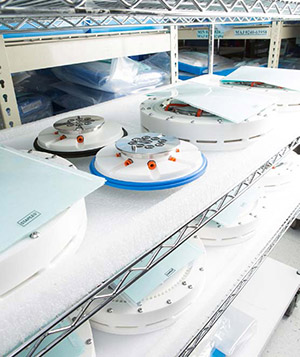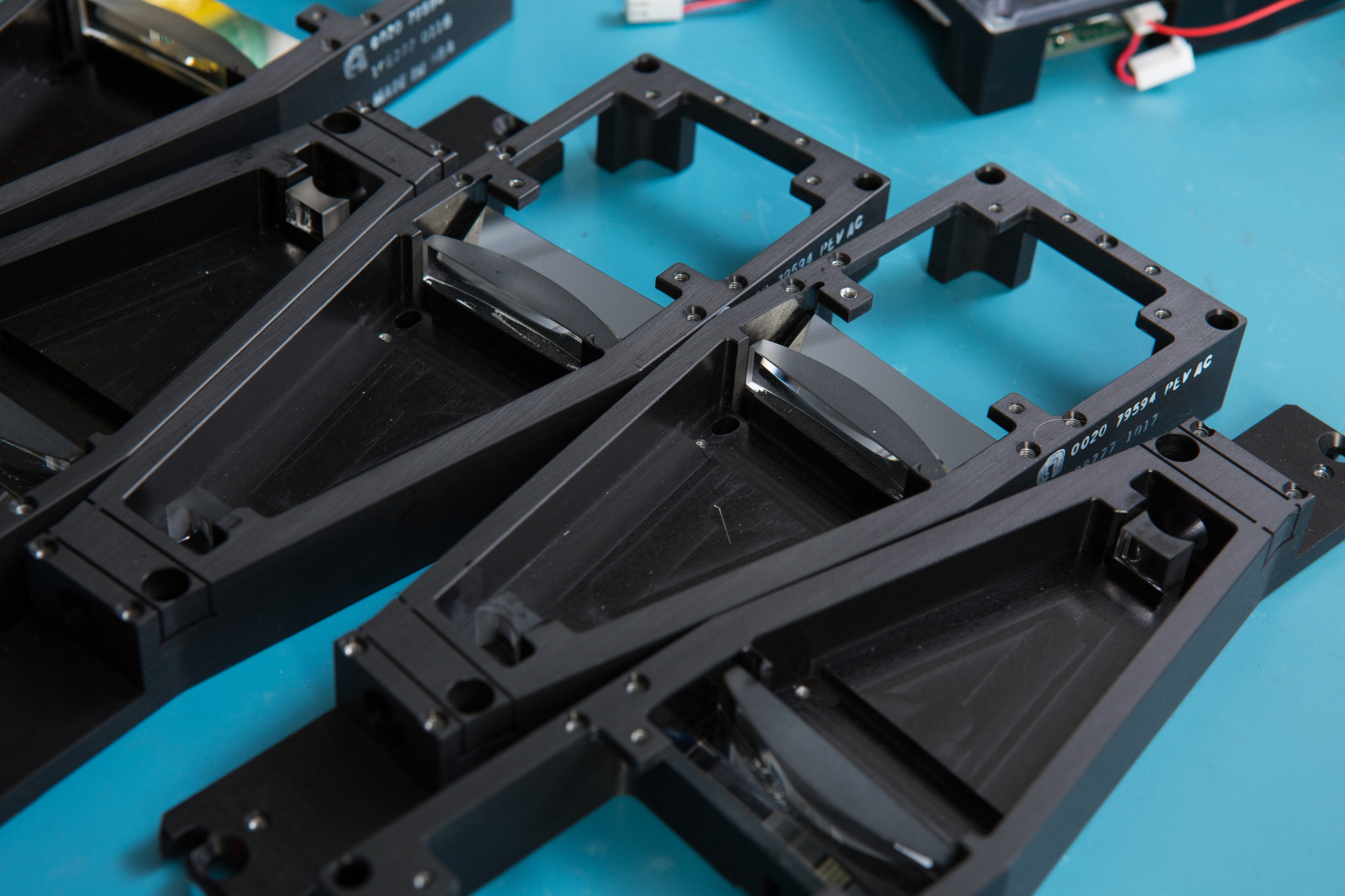Products & Technologies
Back to Menu
Products & Technologies
Services
Resources
TABLE OF CONTENTS
AI Will Enable Next-Generation Quality Systems
Applied and SC Solutions Partner on Real-Time Profile Control for 200mm CMP
Foldable Phones Bend the Limits of Technology
Subject Matter Expertise is Critical for Smart Manufacturing Analytics
The Future of Power Needs to be Exotic
Delivering Service Supply Chain Excellence
By David Lammers
In an industry as demanding as semiconductor manufacturing, where globalization, capital investments, and technical complexity continue to accelerate, the availability of service parts inventory to ensure equipment availability is a critical success factor.
To meet the challenges, Applied Global Services (AGS) has dramatically transformed its service supply chain—arguably the largest and most complex in the semiconductor equipment industry—by implementing new information technology, expanding its service distribution network, developing supplier capability closer to the end customer and exploring the use of AI techniques in planning, forecasting, and fulfillment to improve delivery performance.
Such service network optimization is a never-ending process, but customer surveys and internal metrics indicate that the effort is delivering outstanding results.
Applied’s service supply chain transformation began in earnest several years ago when senior AGS management recognized the strategic need to improve the customer experience through an expanded focus on service products and operational capability. “We needed to devise a streamlined, scalable, highly responsive service supply chain to more reliably supply service parts to our customers’ fabs, wherever they are located—one capable of growing and responding to the needs of customers in both the near- and long-term,” said David Kirkpatrick, managing director of business operations at AGS.


David Kirkpatrick
Kirkpatrick said the management team developed a strategy that “emphasized getting parts to customers faster and more predictably. The team began closely tracking on-time delivery (OTD) to both customer commitments and entitled requests and using these key metrics to drive and monitor network optimization initiatives.“
The service network has been completely redesigned. Regional hubs have been expanded to support differentiated delivery performance. Local service depots were added or expanded as necessary to support expanding installed base and service contracts. And further changes are under consideration as the semiconductor industry and adjacent markets continue to grow.
A MAJOR EFFORT
Applied has more than 40,000 tools in production with many under service agreement. To support this, AGS delivers more than 30,000 orders per week from the company’s global stocking locations. “It took a lot of work to understand the demand rate for each and every part, and to determine what the right stocking strategy would be to meet customers’ needs,” said John Nunes, managing director of service parts planning.
For the service supply chain evolution, AGS built a comprehensive database of its installed base of tools, including highly detailed bills of material (BOM) for each tool, and sought to characterize the failure rate of each part. From that, a statistical model was created to define the parts required at each location. A best-in-class customer relationship management (CRM) tool was integrated into the process, providing a feedback loop to the planning team.

John Nunes
“We developed a capability to monitor inventory levels relative to statistical requirements and developed analytics to automatically identify root cause and corrective action for every delivery excursion. It might be the first time that particular part had failed at that site and we just didn’t know that it would be needed there. Or it might have been a spike in demand that exceeded our statistical expectation. That information fed back to trigger corrective actions,” Nunes said.
The feedback also allows for continuous database updates providing the information needed to further optimize the service network.
PARTS DISTRIBUTION REVAMPED

To better model the parts distribution network, the logistics team used advanced network analysis tools, capturing all inbound data from suppliers, and outbound data to customers in the model.
In addition, the team moved the company’s North America distribution center to a state-of-the-art facility just east of San Francisco, California, to better serve customers in major international markets.
The new distribution center— which ships packages ranging in size from small boxes of specialty screws to huge crates containing sensitive wafer handlers—was built with automation in mind. It has elevated ceilings and aisleways optimized for configurable conveyor belts, robots, and automated picking systems. Plans are underway to further automate the facility, developing techniques that can then be rolled out to other Applied distribution centers worldwide.
“We are working very successfully with all of our partners to capture data. For example, at the new distribution center, we are working with a strategic partner there so that they get live order data feeds, which drives continuous improvement in their warehouses,” said Grant Keyser, AGS managing director of logistics.
AGS is also working with warehouse partners in Asia to develop similar capabilities in that region. And it is developing technologies that will “use RFID and other IoT devices to keep track of materials in our supply chain. We have done an entire re-engineering of the end-to-end service parts fulfillment process. And we have a CRM system that automatically upgrades delivery priority as needed to meet customer contract entitlement,” Keyser said.
SERVICE CONTRACTS
The changes to Applied’s service supply chain came against the backdrop of changes in the 21st century semiconductor industry. At the leading edge, logic and memory companies continue to operate gigascale fabs under intense pressure to increase productivity and to maximize utilization of invested assets. However, what has taken many by surprise is the sustained growth of legacy fabs, which are running full tilt to squeeze out growing numbers of power devices, sensors, analog ICs, discretes, and other components used in the markets for IoT, communications, automotive, power, and more.
As these technical and time-to-market pressures escalated, Applied Materials and its customers formed strategic partnerships to solve evermore-challenging issues, resulting in long-term service agreements between the company and many of its customers.
Applied Materials CEO Gary Dickerson, in a recent quarterly call with financial analysts, said the company’s service business has grown at a double-digit compound annual growth rate over the last four years, with more customers transitioning to service contracts.

“We have a higher percentage—over half of our service business—in subscription revenue with long-term agreements. It comes back to creating value for customers, optimizing output, yield, and cost. We’ve put a tremendous focus there. And we’re getting a lot of traction,” Dickerson said.
Service contracts allow Applied to partner with customers globally to proactively manage their uptime requirements. A key tenet of those service contracts involves fast turnaround of spare parts, with an ability to get parts to customers in hours instead of days or weeks. Contracts give Applied a much more stable planning environment, enabling the company to drive more effective stocking levels.
PLACING CUSTOMERS’ SUCCESS FIRST
Customers are not the only ones providing largely positive feedback on the changes in Applied’s parts logistics operations over the last few years. Applied Materials field engineers have said they also are benefitting from more consistent and faster deliveries, as well as an improved ability to track parts.
Customers’ system uptime and their experience with the Applied Global Services organization are top priorities. “For the service supply chain organization, every business and individual performance review is about the customer experience, about whether we are hitting customers’ targets in terms of spares performance, and their overall satisfaction. We want to make sure when the customer needs a part, we have it ready for them,” Kirkpatrick said.
For additional information contact nanochip_editor@amat.com
